BUGEN 5930 Reflective Journal: Business, Society, and the Planet
VerifiedAdded on 2023/06/09
|5
|1496
|349
Journal and Reflective Writing
AI Summary
This reflective journal delves into the concept of sustainability, particularly the triple bottom line (TBL), and its relevance to the business world. It highlights the TBL framework, encompassing social, environmental, and financial aspects, as a means to measure an organization's impact and generate business value. The reflection covers the dimensions of TBL (people, planet, and profits), challenges in its adoption, and the growing importance of corporate social responsibility (CSR) in attracting talent and ensuring long-term profitability. The journal also addresses how businesses are integrating sustainability into their operations, from reducing environmental footprints to improving product development and engaging suppliers in environmentally friendly practices. It emphasizes that while companies are making strides in sustainability, the overall impact of business activities on the planet continues to grow, necessitating a more holistic approach to CSR and sustainability for the future of business.
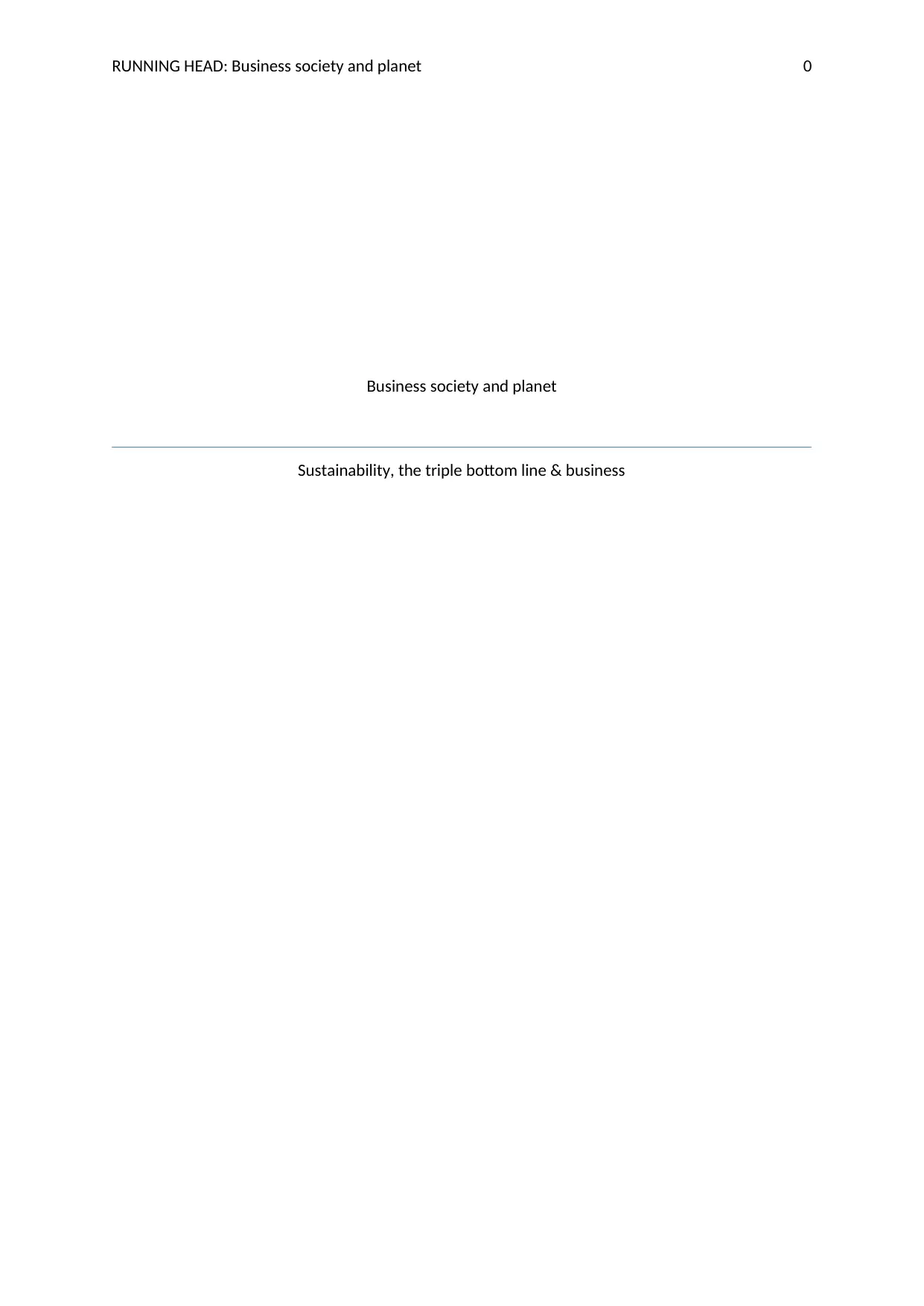
RUNNING HEAD: Business society and planet 0
Business society and planet
Sustainability, the triple bottom line & business
Business society and planet
Sustainability, the triple bottom line & business
Paraphrase This Document
Need a fresh take? Get an instant paraphrase of this document with our AI Paraphraser
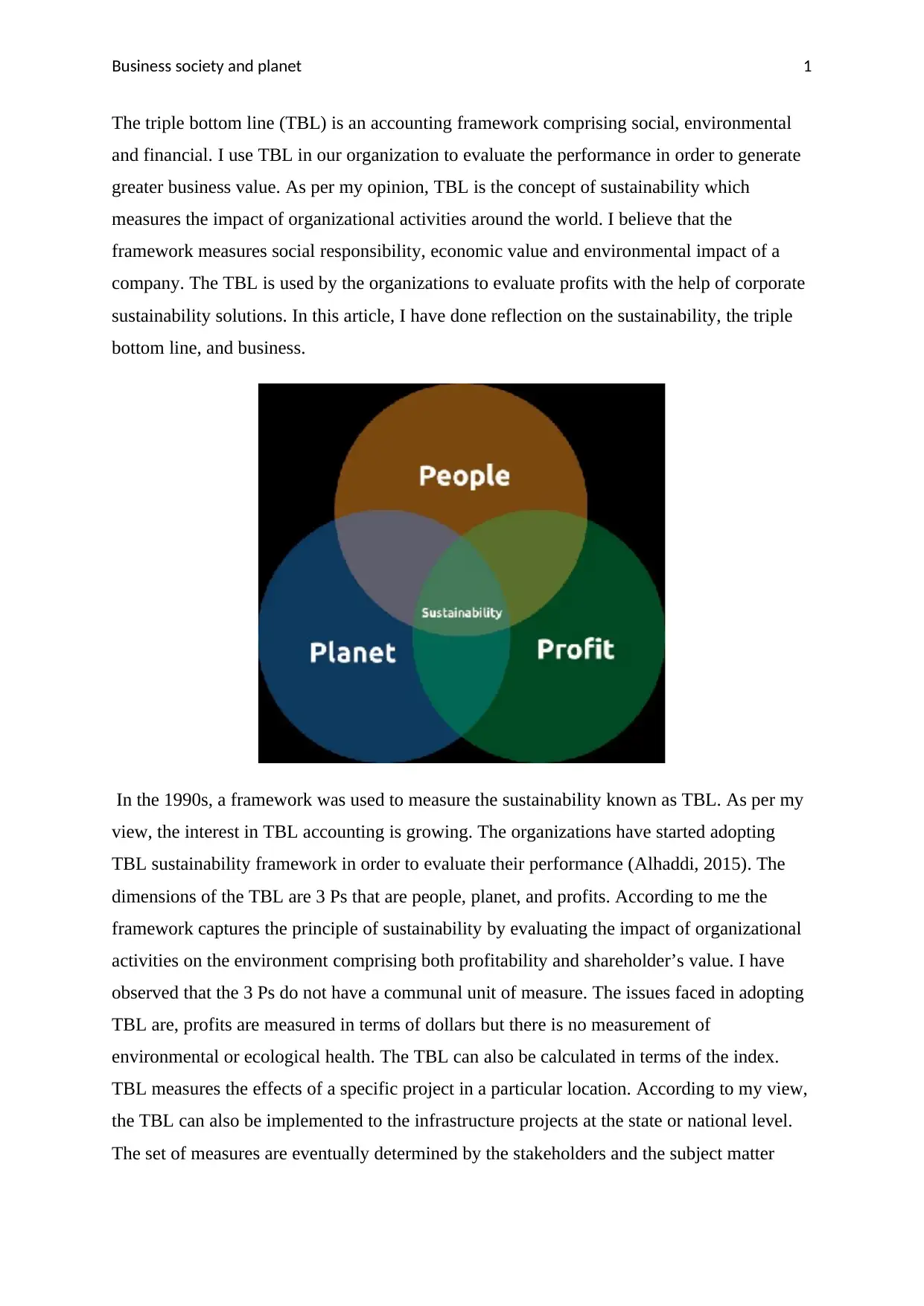
Business society and planet 1
The triple bottom line (TBL) is an accounting framework comprising social, environmental
and financial. I use TBL in our organization to evaluate the performance in order to generate
greater business value. As per my opinion, TBL is the concept of sustainability which
measures the impact of organizational activities around the world. I believe that the
framework measures social responsibility, economic value and environmental impact of a
company. The TBL is used by the organizations to evaluate profits with the help of corporate
sustainability solutions. In this article, I have done reflection on the sustainability, the triple
bottom line, and business.
In the 1990s, a framework was used to measure the sustainability known as TBL. As per my
view, the interest in TBL accounting is growing. The organizations have started adopting
TBL sustainability framework in order to evaluate their performance (Alhaddi, 2015). The
dimensions of the TBL are 3 Ps that are people, planet, and profits. According to me the
framework captures the principle of sustainability by evaluating the impact of organizational
activities on the environment comprising both profitability and shareholder’s value. I have
observed that the 3 Ps do not have a communal unit of measure. The issues faced in adopting
TBL are, profits are measured in terms of dollars but there is no measurement of
environmental or ecological health. The TBL can also be calculated in terms of the index.
TBL measures the effects of a specific project in a particular location. According to my view,
the TBL can also be implemented to the infrastructure projects at the state or national level.
The set of measures are eventually determined by the stakeholders and the subject matter
The triple bottom line (TBL) is an accounting framework comprising social, environmental
and financial. I use TBL in our organization to evaluate the performance in order to generate
greater business value. As per my opinion, TBL is the concept of sustainability which
measures the impact of organizational activities around the world. I believe that the
framework measures social responsibility, economic value and environmental impact of a
company. The TBL is used by the organizations to evaluate profits with the help of corporate
sustainability solutions. In this article, I have done reflection on the sustainability, the triple
bottom line, and business.
In the 1990s, a framework was used to measure the sustainability known as TBL. As per my
view, the interest in TBL accounting is growing. The organizations have started adopting
TBL sustainability framework in order to evaluate their performance (Alhaddi, 2015). The
dimensions of the TBL are 3 Ps that are people, planet, and profits. According to me the
framework captures the principle of sustainability by evaluating the impact of organizational
activities on the environment comprising both profitability and shareholder’s value. I have
observed that the 3 Ps do not have a communal unit of measure. The issues faced in adopting
TBL are, profits are measured in terms of dollars but there is no measurement of
environmental or ecological health. The TBL can also be calculated in terms of the index.
TBL measures the effects of a specific project in a particular location. According to my view,
the TBL can also be implemented to the infrastructure projects at the state or national level.
The set of measures are eventually determined by the stakeholders and the subject matter
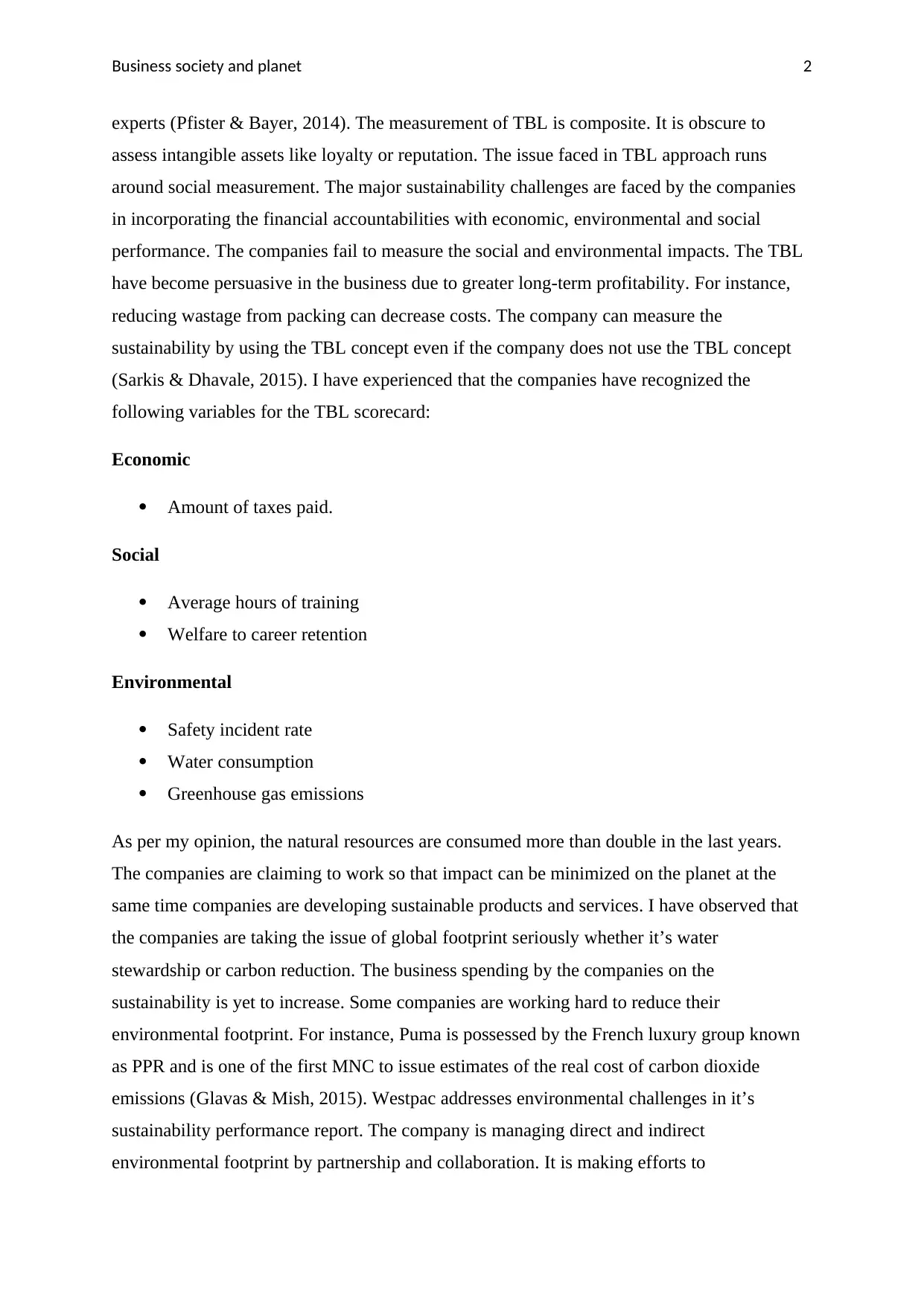
Business society and planet 2
experts (Pfister & Bayer, 2014). The measurement of TBL is composite. It is obscure to
assess intangible assets like loyalty or reputation. The issue faced in TBL approach runs
around social measurement. The major sustainability challenges are faced by the companies
in incorporating the financial accountabilities with economic, environmental and social
performance. The companies fail to measure the social and environmental impacts. The TBL
have become persuasive in the business due to greater long-term profitability. For instance,
reducing wastage from packing can decrease costs. The company can measure the
sustainability by using the TBL concept even if the company does not use the TBL concept
(Sarkis & Dhavale, 2015). I have experienced that the companies have recognized the
following variables for the TBL scorecard:
Economic
Amount of taxes paid.
Social
Average hours of training
Welfare to career retention
Environmental
Safety incident rate
Water consumption
Greenhouse gas emissions
As per my opinion, the natural resources are consumed more than double in the last years.
The companies are claiming to work so that impact can be minimized on the planet at the
same time companies are developing sustainable products and services. I have observed that
the companies are taking the issue of global footprint seriously whether it’s water
stewardship or carbon reduction. The business spending by the companies on the
sustainability is yet to increase. Some companies are working hard to reduce their
environmental footprint. For instance, Puma is possessed by the French luxury group known
as PPR and is one of the first MNC to issue estimates of the real cost of carbon dioxide
emissions (Glavas & Mish, 2015). Westpac addresses environmental challenges in it’s
sustainability performance report. The company is managing direct and indirect
environmental footprint by partnership and collaboration. It is making efforts to
experts (Pfister & Bayer, 2014). The measurement of TBL is composite. It is obscure to
assess intangible assets like loyalty or reputation. The issue faced in TBL approach runs
around social measurement. The major sustainability challenges are faced by the companies
in incorporating the financial accountabilities with economic, environmental and social
performance. The companies fail to measure the social and environmental impacts. The TBL
have become persuasive in the business due to greater long-term profitability. For instance,
reducing wastage from packing can decrease costs. The company can measure the
sustainability by using the TBL concept even if the company does not use the TBL concept
(Sarkis & Dhavale, 2015). I have experienced that the companies have recognized the
following variables for the TBL scorecard:
Economic
Amount of taxes paid.
Social
Average hours of training
Welfare to career retention
Environmental
Safety incident rate
Water consumption
Greenhouse gas emissions
As per my opinion, the natural resources are consumed more than double in the last years.
The companies are claiming to work so that impact can be minimized on the planet at the
same time companies are developing sustainable products and services. I have observed that
the companies are taking the issue of global footprint seriously whether it’s water
stewardship or carbon reduction. The business spending by the companies on the
sustainability is yet to increase. Some companies are working hard to reduce their
environmental footprint. For instance, Puma is possessed by the French luxury group known
as PPR and is one of the first MNC to issue estimates of the real cost of carbon dioxide
emissions (Glavas & Mish, 2015). Westpac addresses environmental challenges in it’s
sustainability performance report. The company is managing direct and indirect
environmental footprint by partnership and collaboration. It is making efforts to
⊘ This is a preview!⊘
Do you want full access?
Subscribe today to unlock all pages.

Trusted by 1+ million students worldwide
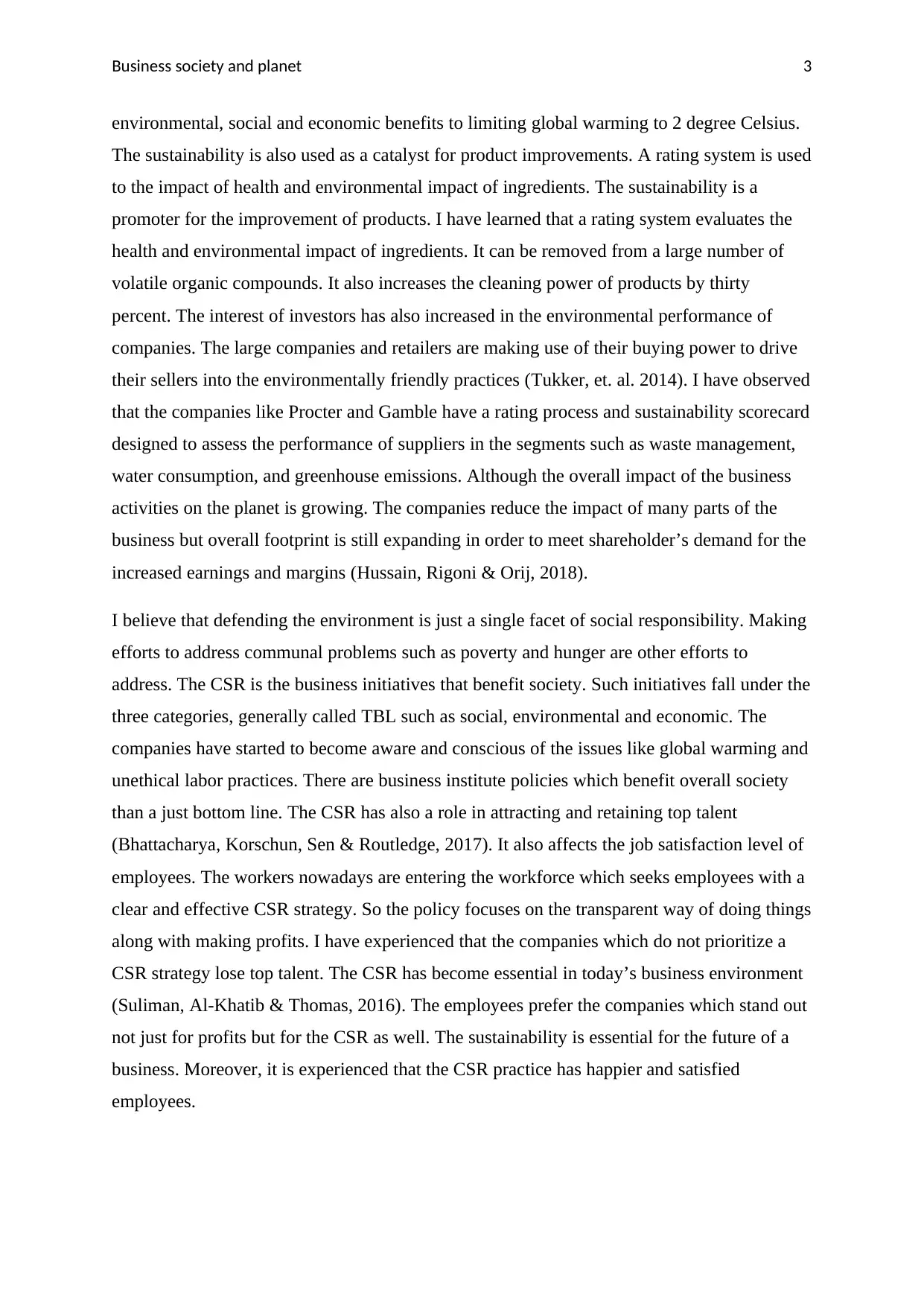
Business society and planet 3
environmental, social and economic benefits to limiting global warming to 2 degree Celsius.
The sustainability is also used as a catalyst for product improvements. A rating system is used
to the impact of health and environmental impact of ingredients. The sustainability is a
promoter for the improvement of products. I have learned that a rating system evaluates the
health and environmental impact of ingredients. It can be removed from a large number of
volatile organic compounds. It also increases the cleaning power of products by thirty
percent. The interest of investors has also increased in the environmental performance of
companies. The large companies and retailers are making use of their buying power to drive
their sellers into the environmentally friendly practices (Tukker, et. al. 2014). I have observed
that the companies like Procter and Gamble have a rating process and sustainability scorecard
designed to assess the performance of suppliers in the segments such as waste management,
water consumption, and greenhouse emissions. Although the overall impact of the business
activities on the planet is growing. The companies reduce the impact of many parts of the
business but overall footprint is still expanding in order to meet shareholder’s demand for the
increased earnings and margins (Hussain, Rigoni & Orij, 2018).
I believe that defending the environment is just a single facet of social responsibility. Making
efforts to address communal problems such as poverty and hunger are other efforts to
address. The CSR is the business initiatives that benefit society. Such initiatives fall under the
three categories, generally called TBL such as social, environmental and economic. The
companies have started to become aware and conscious of the issues like global warming and
unethical labor practices. There are business institute policies which benefit overall society
than a just bottom line. The CSR has also a role in attracting and retaining top talent
(Bhattacharya, Korschun, Sen & Routledge, 2017). It also affects the job satisfaction level of
employees. The workers nowadays are entering the workforce which seeks employees with a
clear and effective CSR strategy. So the policy focuses on the transparent way of doing things
along with making profits. I have experienced that the companies which do not prioritize a
CSR strategy lose top talent. The CSR has become essential in today’s business environment
(Suliman, Al-Khatib & Thomas, 2016). The employees prefer the companies which stand out
not just for profits but for the CSR as well. The sustainability is essential for the future of a
business. Moreover, it is experienced that the CSR practice has happier and satisfied
employees.
environmental, social and economic benefits to limiting global warming to 2 degree Celsius.
The sustainability is also used as a catalyst for product improvements. A rating system is used
to the impact of health and environmental impact of ingredients. The sustainability is a
promoter for the improvement of products. I have learned that a rating system evaluates the
health and environmental impact of ingredients. It can be removed from a large number of
volatile organic compounds. It also increases the cleaning power of products by thirty
percent. The interest of investors has also increased in the environmental performance of
companies. The large companies and retailers are making use of their buying power to drive
their sellers into the environmentally friendly practices (Tukker, et. al. 2014). I have observed
that the companies like Procter and Gamble have a rating process and sustainability scorecard
designed to assess the performance of suppliers in the segments such as waste management,
water consumption, and greenhouse emissions. Although the overall impact of the business
activities on the planet is growing. The companies reduce the impact of many parts of the
business but overall footprint is still expanding in order to meet shareholder’s demand for the
increased earnings and margins (Hussain, Rigoni & Orij, 2018).
I believe that defending the environment is just a single facet of social responsibility. Making
efforts to address communal problems such as poverty and hunger are other efforts to
address. The CSR is the business initiatives that benefit society. Such initiatives fall under the
three categories, generally called TBL such as social, environmental and economic. The
companies have started to become aware and conscious of the issues like global warming and
unethical labor practices. There are business institute policies which benefit overall society
than a just bottom line. The CSR has also a role in attracting and retaining top talent
(Bhattacharya, Korschun, Sen & Routledge, 2017). It also affects the job satisfaction level of
employees. The workers nowadays are entering the workforce which seeks employees with a
clear and effective CSR strategy. So the policy focuses on the transparent way of doing things
along with making profits. I have experienced that the companies which do not prioritize a
CSR strategy lose top talent. The CSR has become essential in today’s business environment
(Suliman, Al-Khatib & Thomas, 2016). The employees prefer the companies which stand out
not just for profits but for the CSR as well. The sustainability is essential for the future of a
business. Moreover, it is experienced that the CSR practice has happier and satisfied
employees.
Paraphrase This Document
Need a fresh take? Get an instant paraphrase of this document with our AI Paraphraser
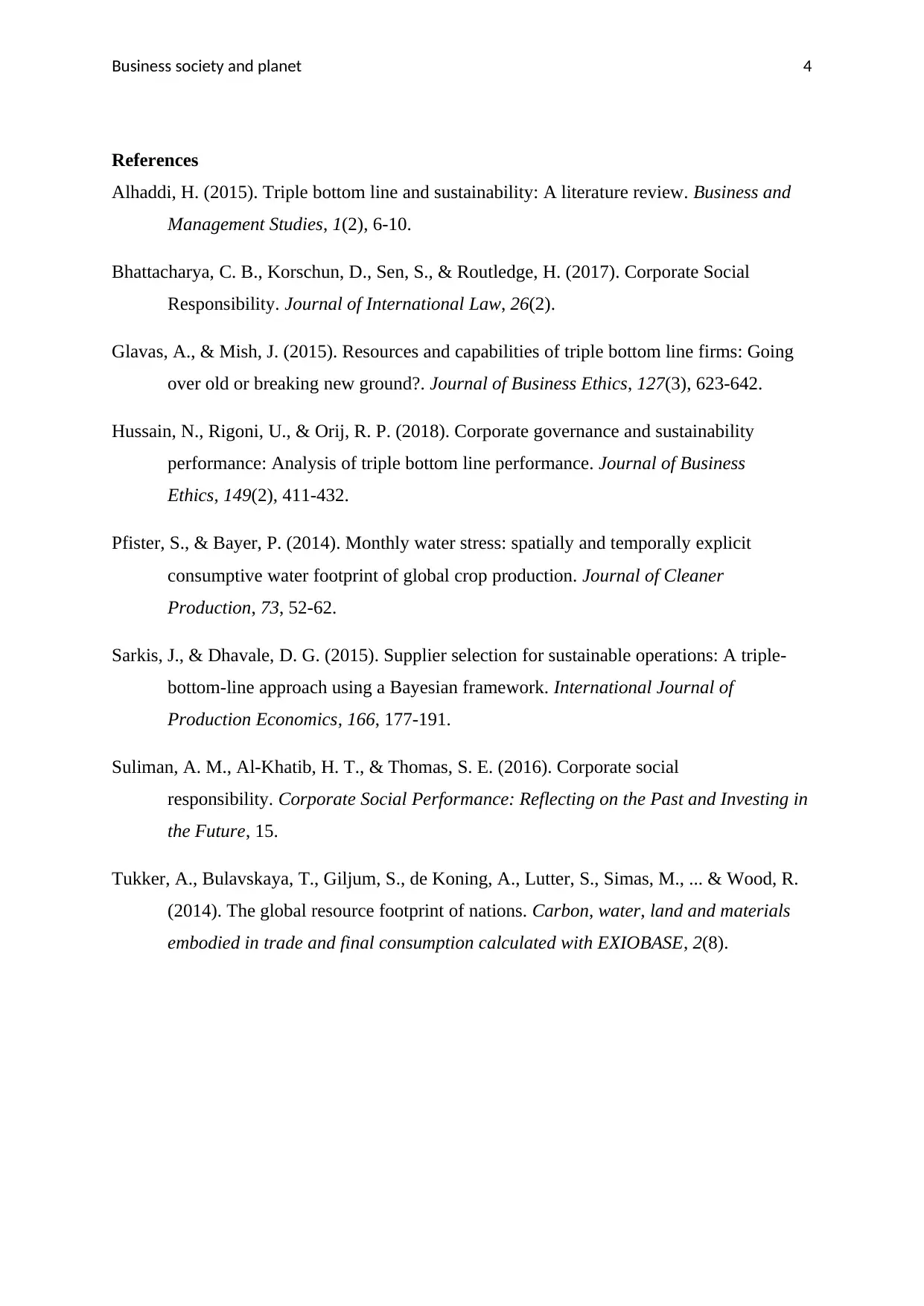
Business society and planet 4
References
Alhaddi, H. (2015). Triple bottom line and sustainability: A literature review. Business and
Management Studies, 1(2), 6-10.
Bhattacharya, C. B., Korschun, D., Sen, S., & Routledge, H. (2017). Corporate Social
Responsibility. Journal of International Law, 26(2).
Glavas, A., & Mish, J. (2015). Resources and capabilities of triple bottom line firms: Going
over old or breaking new ground?. Journal of Business Ethics, 127(3), 623-642.
Hussain, N., Rigoni, U., & Orij, R. P. (2018). Corporate governance and sustainability
performance: Analysis of triple bottom line performance. Journal of Business
Ethics, 149(2), 411-432.
Pfister, S., & Bayer, P. (2014). Monthly water stress: spatially and temporally explicit
consumptive water footprint of global crop production. Journal of Cleaner
Production, 73, 52-62.
Sarkis, J., & Dhavale, D. G. (2015). Supplier selection for sustainable operations: A triple-
bottom-line approach using a Bayesian framework. International Journal of
Production Economics, 166, 177-191.
Suliman, A. M., Al-Khatib, H. T., & Thomas, S. E. (2016). Corporate social
responsibility. Corporate Social Performance: Reflecting on the Past and Investing in
the Future, 15.
Tukker, A., Bulavskaya, T., Giljum, S., de Koning, A., Lutter, S., Simas, M., ... & Wood, R.
(2014). The global resource footprint of nations. Carbon, water, land and materials
embodied in trade and final consumption calculated with EXIOBASE, 2(8).
References
Alhaddi, H. (2015). Triple bottom line and sustainability: A literature review. Business and
Management Studies, 1(2), 6-10.
Bhattacharya, C. B., Korschun, D., Sen, S., & Routledge, H. (2017). Corporate Social
Responsibility. Journal of International Law, 26(2).
Glavas, A., & Mish, J. (2015). Resources and capabilities of triple bottom line firms: Going
over old or breaking new ground?. Journal of Business Ethics, 127(3), 623-642.
Hussain, N., Rigoni, U., & Orij, R. P. (2018). Corporate governance and sustainability
performance: Analysis of triple bottom line performance. Journal of Business
Ethics, 149(2), 411-432.
Pfister, S., & Bayer, P. (2014). Monthly water stress: spatially and temporally explicit
consumptive water footprint of global crop production. Journal of Cleaner
Production, 73, 52-62.
Sarkis, J., & Dhavale, D. G. (2015). Supplier selection for sustainable operations: A triple-
bottom-line approach using a Bayesian framework. International Journal of
Production Economics, 166, 177-191.
Suliman, A. M., Al-Khatib, H. T., & Thomas, S. E. (2016). Corporate social
responsibility. Corporate Social Performance: Reflecting on the Past and Investing in
the Future, 15.
Tukker, A., Bulavskaya, T., Giljum, S., de Koning, A., Lutter, S., Simas, M., ... & Wood, R.
(2014). The global resource footprint of nations. Carbon, water, land and materials
embodied in trade and final consumption calculated with EXIOBASE, 2(8).
1 out of 5
Related Documents
Your All-in-One AI-Powered Toolkit for Academic Success.
+13062052269
info@desklib.com
Available 24*7 on WhatsApp / Email
![[object Object]](/_next/static/media/star-bottom.7253800d.svg)
Unlock your academic potential
Copyright © 2020–2025 A2Z Services. All Rights Reserved. Developed and managed by ZUCOL.





